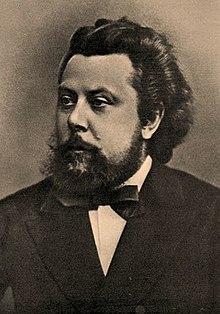Modest Petrovic Mussorgsky
1839 - 1881
Pianist and composer, Mussorgsky was an innovator of Russian music. He strove to achieve a uniquely Russian musical identity, often in deliberate defiance of the established conventions of Western music. Mussorgsky depicts in his music "the insulted and the injured" with all their passion and pain. Many of his major works were inspired by Russian folklore and other nationalist themes, including the piano suite Pictures at an Exhibition. However, while Mussorgsky's music can be vivid and nationalistic, it does not glorify the powerful and is at times antimilitaristic. For this reason, he were considered dangerous extremists by the emperor and his court. For many years Mussorgsky's works were mainly known in versions revised or completed by other composers. Many of his most important compositions have recently come into their own in their original forms, and some of the original scores are now also available.
A Night on Bald Mountain
Inspired by an ancient Russian legend according to which on the night of S. Giovanni (June 23-24) a witch's sabbath ritually occurs, Mussorgsky wrote a first orchestral version of the piece in 1867 and another for chorus and orchestra in 1872. The opera that we know today in the Ravel’s symphonic version is, in reality, a posthumous re-elaboration by Rimskj Korsakov principally based on the score of 1872 but without the chorus. Paolo Marzocchi carried out his remarkable concert transcription basing it on this apocryphal piece.
Pictures at an Exhibition
In 1873 death claimed the Russian painter – architect Victor Hartmann. Mussorgsky and Hartmann had been close friends and, after attending memorial exhibition of the artist’s works, Mussorgsky was inspired to interpret 10 of the drawings in a suite for piano (1874). The ten pieces are preceded by a reoccurring theme that Mussorgsky entitled Promenade and that must be intended as the author's movement among the drawings.
1) Promenade:
A richly harmonized pentatonic introduction, sonorous and radiant, characterizes the first exhibition of this re-occurring theme. The melody and rhythm resemble Russian folk songs.
2) Gnomus:
The piece describes a being whose grotesque appearance borders on the demonic. Scattered with disonance and acid notes, the score contains bursts of extreme vitality, laced with tension charged pauses.
3) Promenade:
The theme is played by the left-hand, sweet and delicate and it magnificently introduces the dreamy and melancholy atmosphere of the next painting.
4) The Old Castle:
Two principal themes, one serious and the other more cantabile flow
on an atemporal nostalgic sustained bass note. This piece is based on Hartmann’s painting of a troubadour singing in front of a castle.
5) Promenade:
Solemn and very martial, it breaks the spell of the preceding piece in order to quickly project the listener onto the next painting.
6) Tuileries:
In the famous Parisian gardens, a squabble among children is represented after playing. A vivacious and light piece of a spiteful spirit.
7) Bydlo:
The Polish cart drawn by ox is the symbol of hard work. The obstinate here keeps the rhythm of the heavy, regular march, at the peak of which rises spacious and robust singing.
8) Promenade:
It's the first time that the theme in a minor key is heard in a refined harmonization that creates an enigmatic setting.
9) Ballet of the Unhatched Chicks:
A masterpiece of musical humour. The sound of the piano bends in an almost onomatopoeic way in the search for the twittering and chirping of the little chicks still closed inside their eggshells.
10) Samuel Goldenberg and Schmuyle:
Two Polish Jews, one rich and the other poor, in a praiseworthy psychological scene: the arrogance of the first, characterized by a theme authentically Jewish that is executed in unison, contrasts with the incessant supplication, the repeated notes of the beggar.
11) Promenade:
It’s the twin of the first piece; Mussorgsky introduces some small variations to give more dash to the musical discourse.
12) Limoges-the Market:
In this popular scene, from the irresistible liveliness, Mussorgsky imagined a piece in a joking form that portrays the vivacious women's gossip.
13) Catacombs (Sepulchrum romanum):
Notable harmonies and chords from the resonance of the organ in a language that to a large extent anticipates some innovations of music in the XX century.
14) Con Mortuis in Lingua Morta:
A promenade through the catacombs: all of a sudden in transparency underneath a wavering tremolo, the principle theme reappears like a light that illuminates the underworld. Cum Mortuis in Lingua Mortua meaning With the dead in a dead language.
15) Baba -Yaga:
Baba-Yaga is the witch of the Russian fairytales. She lives in 'The Hut on Hen's Legs'. Hartman painted a design for a clock based on the hut. This piece is one of the more demanding of the set with a 64th note tremolo during the entire middle part.
16) The Great Gate of Kiev
It is based on sketches Hartmann made for a planned (but never built) monumental gate for Tsar Alexander II. Mussorgsky’s music is noble and richly colored, evoking a great procession passing through the gate.
Mussorgsky's Pictures by Andrea Corazziari





